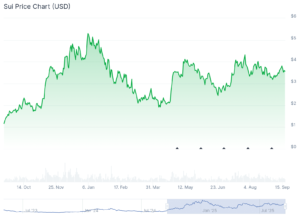Bitcoin Surges to $107K Amidst Political Tensions: How Investors Can Capitalize

Introduction
Bitcoin has once again defied expectations, breaking through the staggering $107,000 price barrier and setting a new all-time high. This significant milestone has galvanized both retail speculators and institutional investors, who are now flocking back into the cryptocurrency market with renewed vigor. The timing of this bullish momentum is noteworthy—it comes amidst a backdrop of growing political upheaval. Former President Donald Trump’s controversial move to deploy the National Guard to Los Angeles, following a surge in civil demonstrations, underscores the rising instability across traditional global systems. While many traditional markets have responded with volatility and uncertainty, crypto veterans see a familiar pattern: chaos in global affairs often translates into bullish opportunities for decentralized assets. As mainstream confidence wavers, the allure of blockchain-based stores of value becomes even more pronounced.
Understanding Market Volatility
Market volatility, particularly within the cryptocurrency sector, should not be misunderstood simply as risk—it is also a reflection of transformation and opportunity. The current rise in Bitcoin’s price highlights one of the unique traits that crypto assets possess: their inverse correlation with traditional markets in periods of crisis. Bitcoin (BTC), widely known as digital gold, often experiences surges in demand during times of systemic doubt, particularly when fiat currencies struggle to maintain their credibility.
This isn’t a new trend. The 2008 financial crisis birthed Bitcoin. Subsequent economic shocks—such as the COVID-19 pandemic and 2023 debt ceiling debates—have consistently shown that Bitcoin and other decentralized assets can act as financial lifeboats. These macroeconomic and geopolitical triggers catalyze movement not merely due to speculation, but because they cast doubt on the sustainability and transparency of centralized financial systems. Institutional players, from hedge funds to publicly traded companies, have begun treating Bitcoin as a strategic long-term hedge for this very reason.
Investors looking to understand how such external stressors affect Bitcoin’s valuation should delve into comprehensive educational resources like this overview of Bitcoin (BTC), which explores the foundational reasons behind Bitcoin’s growing credibility and long-term potential during uncertain times.
The Importance of Risk Management in Crypto
As the market enters another bull phase, risk management becomes more than a suggestion—it becomes essential for survival. The meteoric rise of Bitcoin can easily spark FOMO (fear of missing out), driving impulsive decisions among retail investors. However, seasoned traders understand that excitement without strategy is a recipe for disaster. Effective risk management involves a set of disciplined strategies that limit emotional decision-making while protecting capital during inevitable pullbacks.
Begin with simple tools like setting predefined stop-loss levels, so that your positions automatically close out before devastating losses occur. Next, avoid high leverage unless you have extensive experience and robust protections in place. Cryptocurrency markets are notorious for their volatility—a double-edged sword that offers high returns, but with enhanced risk.
Diversification across a portfolio is also crucial. Consider allocating a portion of your holdings into lower-risk digital assets like stablecoins or even non-crypto instruments to maintain a liquidity buffer. View volatility as a feature of the crypto market. With the correct strategy, you can leverage this volatility for gain without exposing yourself to unnecessary downside risks. Remember: proper risk management transforms crypto investing from gambling to strategic wealth-building.
Long-Term Investment Strategies
Bitcoin’s soaring prices may grab headlines, but the real value lies in its long-term fundamentals. Why does Bitcoin continue to lure long-term investors year after year, despite dramatic highs and unnerving lows? The answer lies in its sustaining principles: fixed supply, decentralized governance, network security, and increasing institutional adoption make Bitcoin a robust long-term asset.
Long-term investors understand that short-term noise is often driven by narratives or headlines that do not alter the core proposition of Bitcoin. For this reason, strategies like dollar-cost averaging (DCA)—where investors invest a fixed amount at regular intervals—have stood the test of time. Rather than attempting to time the top or bottom, DCA smoothes out volatility and allows participants to benefit from the long-term upward trend of valuable blockchain assets.
Further, periods of uncertainty—whether caused by political instability or economic downturn—can serve as excellent entry points for those with a contrarian mindset. Instead of panicking during price drops, savvy investors recognize these moments as discounted opportunities. If you’re curious about unconventional approaches to investing in the crypto markets, learn more about what it means to be a contrarian investor.
Expanding Beyond Bitcoin: Diversification is Key
While Bitcoin remains the flagship asset of the cryptocurrency world, it would be short-sighted to limit your exposure solely to BTC. A comprehensive crypto portfolio includes a diverse array of other digital assets, each offering unique utility, growth potential, and risk profiles. Ethereum (ETH), for example, has carved out its domain with smart contract functionality, allowing developers to build decentralized applications (dApps), decentralized finance (DeFi) services, and non-fungible token (NFT) marketplaces.
In times of increasing state surveillance or erosion of privacy rights, privacy-oriented coins like Monero (XMR) and Zcash (ZEC) can rise in relevance and demand. These assets offer greater transactional privacy, which can be a critical need for users in politically unstable regions or under regimes with tight financial oversight.
Stablecoins like USDC and USDT—pegged to the U.S. dollar—provide temporary shelter during periods of extreme price volatility without needing to exit the cryptocurrency space entirely. They allow crypto traders and investors to maintain exposure to the digital economy, keep capital liquid, and avoid losses during downturns.
Ultimately, diversification is more than a risk management strategy—it’s a growth amplifier. By exposing your portfolio to different asset classes, sectors, and use-cases within the blockchain space, you increase your chances of catching the next wave of innovation or parabolic price action.
Keeping Informed in a Rapidly-Changing Landscape
In crypto, the only constant is change. Prices are influenced not only by network upgrades and blockchain development milestones but also by social media chatter, mainstream adoption by corporations, regulatory announcements, and even celebrity endorsements. A single tweet from a high-profile figure can create a cascade of buying or selling in minutes.
To stay ahead in this fast-moving environment, it’s crucial to consume information proactively and from credible sources. Bookmark reputable cryptocurrency news outlets, subscribe to newsletters from vetted analysts, follow experts on social media platforms like Twitter and LinkedIn, and keep tabs on global and local events that could tangibly affect economic sentiment.
More critically, allow context and data to shape your interpretation of events. Don’t just absorb news—analyze it. What does a new regulatory framework mean for DeFi? How might rising interest rates influence stablecoins? Reflecting on these questions and understanding the implications behind the headlines can arm you with insights other investors miss.
Conclusion
Bitcoin’s groundbreaking ascent past $107,000 isn’t just breaking barriers—it’s broadcasting a profound message to investors worldwide. As traditional systems falter under the weight of political and economic unrest, decentralized finance offers stability, transparency, and long-term opportunity. Amid riots, regulatory challenges, and market hesitations, Bitcoin and its crypto counterparts stand tall—not just as speculative tickets, but as future-forward solutions for a digitally evolving world.
Do not be misled by short-term fear or hype. Instead, elevate your strategy: commit to diversified holdings, apply rigorous risk-management tactics, and stay grounded in the foundational truths that underpin blockchain technology’s rise. In moments of chaos, it’s often the contrarian investor—the one who moves carefully while others panic—who reaps the most substantial rewards. If you’re ready to develop a mindset that sees volatility as a stepping stone rather than a stumbling block, consider embracing the lessons of the contrarian investor.






